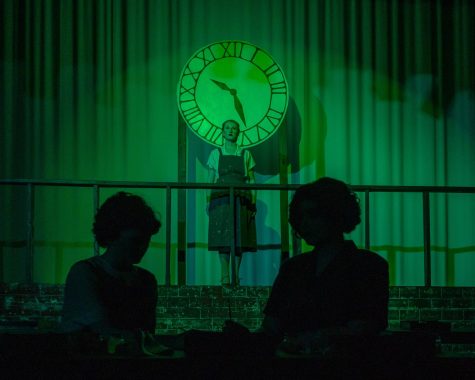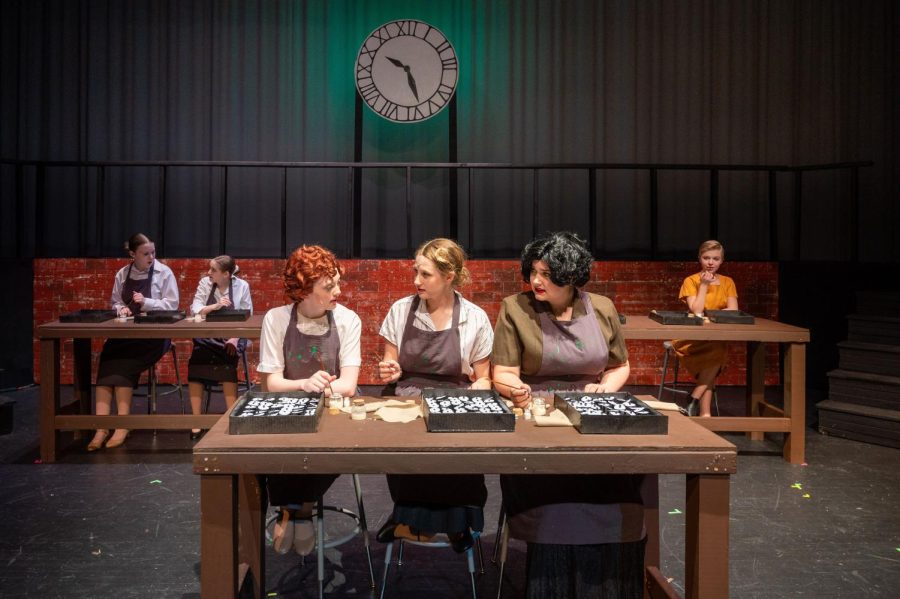Lancer Spotlight 11/16/21: Radium Girls glows as fall play debuts
Grace Fryer (Mary Bailey), Kathryn Schaub (Maggie Glassman, and Irene Rudolph (Malia Smaha) sit at their work bench unaware of the future that awaits them.
November 22, 2021
On November 11 – 14, The drama department presented Radium Girls, starring Mary Bailey, Maggie Glassman and Malia Smaha as factory workers who are poisoned by their work with the radioactive element, radium. The play was co-directed by Angela Smithhisler and Dan Lake and Kate Stadter (Stage Manager).
Radium Girls is based on true events that happened in the 1920’s. Based in Orange, New Jersey, workers for the U.S. Radium Corporation started to get sick and die. The play focuses on the story of Grace Fryer (played by Mary Bailey) and her two friends Irene Rudolph (played Malia Smaha) and Kathryn Schaub (played by Maggie Glassman). The three main characters worked in the factory as dial painters, painting watch dials with radium paint for the men in the war.
The ladies would lick the tips of the brushes to form a sharp point. This helped get precise numbers on the watches, but, in doing so, they ingested the radium paint, making them sick. Because the company, and most of America, believed radium was a health benefit, at first no one made the connection. Later, the company realized the workers were getting sick and began an elaborate cover-up, misdiagnosing the workers and denying lawsuits. Irene Rudolph passed away, leaving her two friends in shock.

Grace Fryer suspected that something was wrong and found out that it was radium causing the illnesses. Filing a lawsuit against the U.S. Radium Corporation proved to be a very difficult and painful process. The corporation tried many times to silence the women coming forward in the lawsuit by bribing them.
Grace Fryer stayed strong and won a settlement of $10,000 ($600 annually). She died shortly after the settlement.
The play was executed well. Actors dressed in paint splattered smocks lit up in “radium paint.”
“We took glow in the dark paint and hit them together to splatter it on. We focused more on the three main girls so they would have more splatter,” said Head of Costumes Alaina Cox.
The soundtrack of Radium Girls was equally amazing, leaving me feeling even more immersed by the play. Another key part to the play was the stage crew that were quick and efficient in changing the scenes from the factory work house to a new house setting.

The actors’ emotions also allowed me to feel their pain as if I was the one dying from a terminal illness. Though it was sad, the actors also showed anger at their situation, expressing this with in play with yells that made the crowd jump. It was also nice to see the attention to detail they had. As the play progressed, the sicker and paler the factory workers looked.
To me this play was a good representation of workers coming together to fight back against big corporate heads. It was a realistic portrayal of both sides facing repercussions, and it didn’t have a fairy tail ending. It still showed the movement of workers which can be related to today as more workers are fighting against companies for better working conditions.
“It portrays a moment in time where girls had to fight to have their voices to be heard and had to fight for their safety,” said actress Lily Hanson.
The drama department is planning the musical Freaky Friday in the spring.













